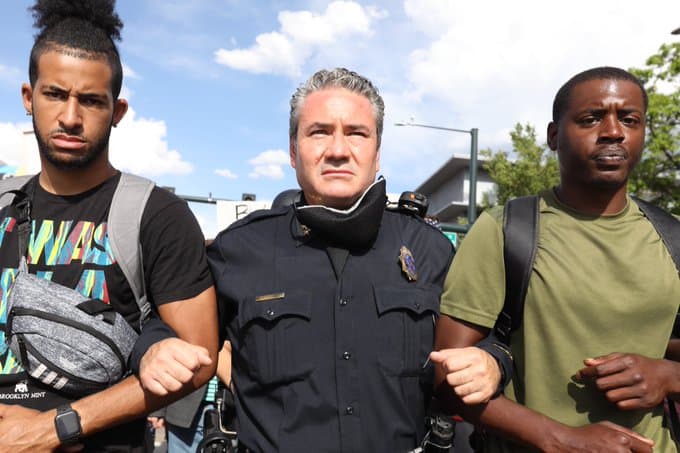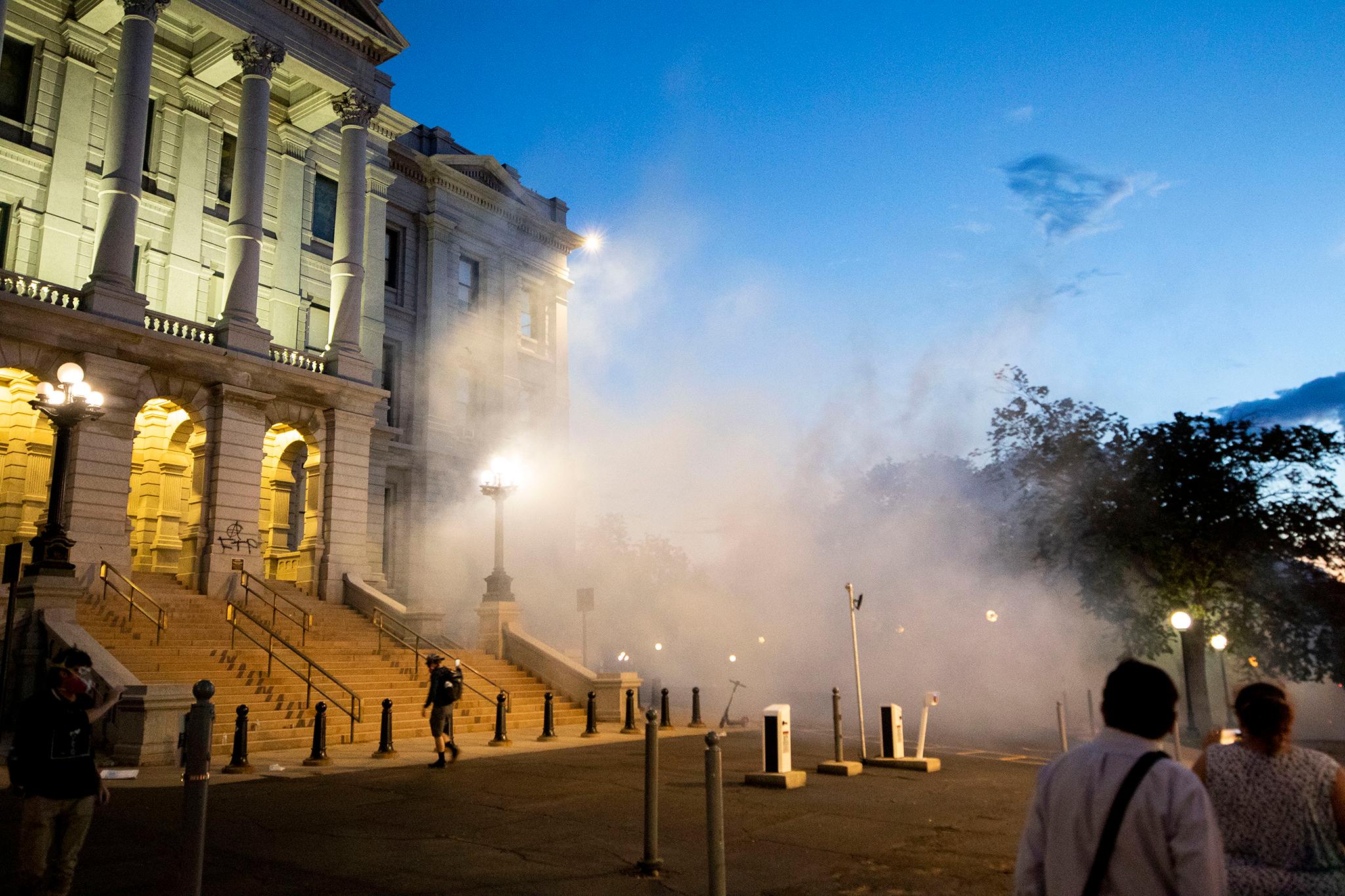Protesters gathered in Civic Center Park. Police responded in riot gear, and used pepper balls and tear gas to control the crowd. Injuries happened on both sides.
This happened not only in the past couple of weeks, but also on October 29, 2011.
That fall, the Occupy protest movement that had originated in New York City arrived in Denver. Protesters erected tents in Civic Center Park, which brought about some sanitation and safety issues.
On October 29, police were dispatched to provide security in the area, according to a report from the Office of the Independent Monitor, Denver's civilian-led agency that oversees investigations into law enforcement departments.
"Officers were faced with a difficult decision -- whether to immediately engage members of the crowd to ensure that the tents come down, risking confrontation -- or wait and allow the crowd to disperse before enforcing that ordinance," the OIM report states.
Police dressed in riot gear verbally requested that the tents be dismantled. Many demonstrators became physically aggressive, according to the report, surrounding the small group of officers. Police called in back-up, and deployed pepper spray and pepper balls. "Several civilians were injured during the ensuing melee," including one who was struck in the face, the OIM report states. An officer was trampled.
The incident received local and national media attention, and complaints against the police department were filed with the OIM.
The independent monitor's subsequent report stated: "It was unfortunate that this confrontation occurred. Yet, it also presented an opportunity to review and learn from the tactics used with the goal of improving outcomes at future demonstrations."
And yet according to that section of the report called "Missed Opportunity for In-depth Tactics Review," the Department of Safety, which oversees all law enforcement agencies and the fire department, declined to investigate how police responded to Occupy protesters.
On Friday night nearly a decade later, on the ninth straight day of protests in Denver against racism and police brutality, a federal judge banned DPD from utilizing non-lethal force, including pepper balls and pepper spray, against peaceful protesters.
Judge R. Brooke Jackson's ruling came from a lawsuit filed by a group of protesters against the department, alleging it had violated their First Amendment rights.
"Police have a very difficult and often thankless job. They frequently are called upon to make split second decisions and to expose themselves to danger while protecting the health and safety of the rest of us," Jackson wrote. But he continued, "Some of the behavior of what I hope and believe to be a minority of the police officers in Denver and the nation during recent days ... not only vis a vis persons of color but against peaceful protesters of all backgrounds have been disgusting."
Thousands have gathered around the State Capitol every day since May 28 to protest the in-custody death of George Floyd. The protests have largely started and stayed peaceful, but the first few days also saw unrest as some people threw rocks and water bottles at police in riot gear, who lobbed tear gas canisters into crowds and shot pepper balls at protesters.
Under Jackson's ruling, police are now only allowed to use chemical weapons or projectiles with an on-scene supervisor's authorization. The supervisor must personally witness acts of violence or destruction of property before making the call. Non-lethal force can't be used indiscriminately in a crowd, and all officers must wear functioning body cameras.
The city of Denver filed a motion to amend the judge's ruling. The city contends the ruling requiring certain supervisor approval before firing chemical weapons isn't feasible because under DPD's command structure, only four captains and one commander are responsible for the downtown area.
"Therefore, the Denver Police Department needs to be able to utilize its Lieutenants, who also have a command rank, to ensure that authorizations of reasonable and necessary force may be made when necessary," the city wrote.
"Without this ability, officers will not be able to act to protect themselves or others."
The city also asked that the ruling exclude the requirement that all police officers wear functioning body cameras, citing technical limitations and arguing that not all the departments that have assisted Denver during protests have such technology.
DPD did not immediately return a request for comment for this story but tweeted that it was complying with Jackson's ruling and that many are already in line with its use-of-force policy.
That policy came about in 2018 after years of violent clashes between police and residents, resulting in multiple deaths and millions of dollars in settlements paid out by the city.
It lays out how officers can utilize lethal and non-lethal force, and what conditions must be in place. (Chief Paul Pazen has said every officer has been trained on it.) Non-lethal force like their body weight and crowd control measures like pepper spray can only be used to prevent injury to an officer or someone else, and to quell rioting and disperse unlawful crowds. "When possible," officers and supervisors should strategize prior to using non-lethal force and give "clear and concise" commands before, during and after deploying it.
Officers are not allowed to target heads, eyes, throats, necks, genitalia or spinal columns. Pepper balls can only be used "when ordered by a field force command or other command officer in crowd control or riot situations."

The plaintiffs -- Agazi Abay, Gabriel Thorn, Amy Schneider and Michael McDaniel -- allege the police have nevertheless used these tactics against peaceful protesters, and caused severe injuries, including loss of vision, fractured bones requiring surgery, deep lacerations, loss of eyes and ruptured testicles.
Three of the four plaintiffs in the case, including Schneider, are white, she acknowledged. She wonders if their case would have been heard and ruled upon so quickly -- it took the judge just two days -- if that hadn't been the case.
"I was shocked," she said regarding the speed at which the ruling came down. "At the same time, I wasn't. Winning against the police is almost unheard of. But three out of the four plaintiffs were white people. I don't think it's a coincidence that they listened to us about police brutality when Black people have been speaking out against this forever. Win a lawsuit in two days? This has been an experience in my level of privilege."
Schneider, a labor organizer, has been protesting all week in Denver. She said that on Monday night, police surrounded the group she was with and tackled her to the ground. At the press conference announcing her lawsuit, she pointed to bruises she said came from their pepper balls.
Schneider said she's been protesting police brutality for a decade. She never went to Denver's Occupy protests, which focused on economic inequality following the Great Recession, but attended similar gatherings in New York City. Even there, she didn't see police utilize tear gas.
"There has never in my experience been this level of policing at protests," she said of the recent events in Denver. "You would see one person brutalized, which is still too many, but not an entire crowd. Not never, but rarely. I never got tear gassed."
Schneider said she attributes police response in Denver to the overall militarization of police, a trend that began in the 1990s to fight the war on drugs. After the uprising in Ferguson, Missouri, over the death of Michael Brown at the hands of police in 2014, then-President Barack Obama downsized a Pentagon program that had been providing police departments with surplus military equipment, including armored assault vehicles and tear gas. President Trump reversed Obama's order in 2017.
Videos circulated social media last week showing protesters throwing fireworks at police officers in Denver, and officers shooting pepper balls at moving vehicles. Early on in the protest, Pazen said DPD deployed officers in riot gear after one had been hit in the head with a rock.
Schneider said she's seen mostly peaceful protesters, and any attempts from the crowd to incite violence have been squashed internally.
"People aren't violent," she said. "The most I've seen is people throwing a water bottle. I don't know the amount of mental gymnastics people have been doing to compare a water bottle to a pepper bullet."
This article has been updated to clarify the issues the city said the tents in Civic Center Park during the Occupy protests raised.













